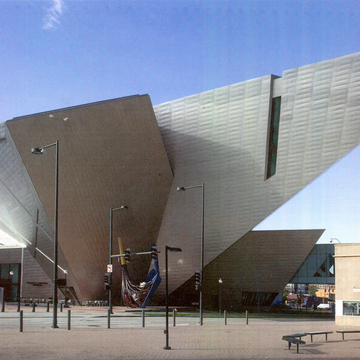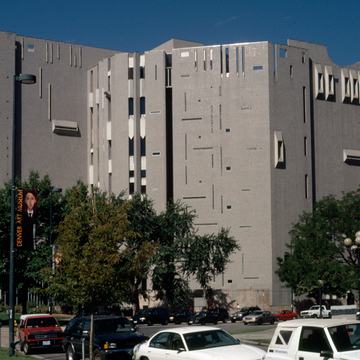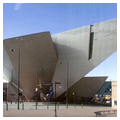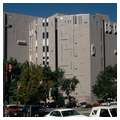Both I. M. Pei and Le Corbusier turned down this commission before it was accepted by Gio Ponti of Milan, a free-spirited creator of everything from factories to espresso machines. Ponti collaborated on his only U.S. building with Denver architect James Sudler to make the museum a dramatic piece of art that demands attention. Their moated castle is clad in custom Corning polished glass tile with seemingly random window slits, some in protruding surrounds. It has been called, by San Francisco Chronicle architecture critic Allen Temko, “the largest lavatory in the world.” The reinforced concrete frame carries twenty-eight vertical sides rising to crenelated parapets at the roofline. These tall slabs disguise the relative simplicity of the plan, which consists of two squares with cut corners joined at the utility core. A dramatic entrance through an elliptical concrete tunnel sheathed in stainless steel transports visitors to an airy lobby and stacked, vertical galleries. Each gallery focuses on specific collections, of which the most notable is Native American art. Despite the interior, this building is damned by its slabby exterior walls, which give it the look of a fortress protecting its loot from the hordes. Worse, its huge bulk belittles the City Beautiful idea of generous landscaping and overshadows the nearby City and County Building.
You are here
Denver Art Museum
1971, Gio Ponti with James Sudler Associates. 100 W. 14th Ave., between Acoma and Bannock sts.
If SAH Archipedia has been useful to you, please consider supporting it.
SAH Archipedia tells the story of the United States through its buildings, landscapes, and cities. This freely available resource empowers the public with authoritative knowledge that deepens their understanding and appreciation of the built environment. But the Society of Architectural Historians, which created SAH Archipedia with University of Virginia Press, needs your support to maintain the high-caliber research, writing, photography, cartography, editing, design, and programming that make SAH Archipedia a trusted online resource available to all who value the history of place, heritage tourism, and learning.








